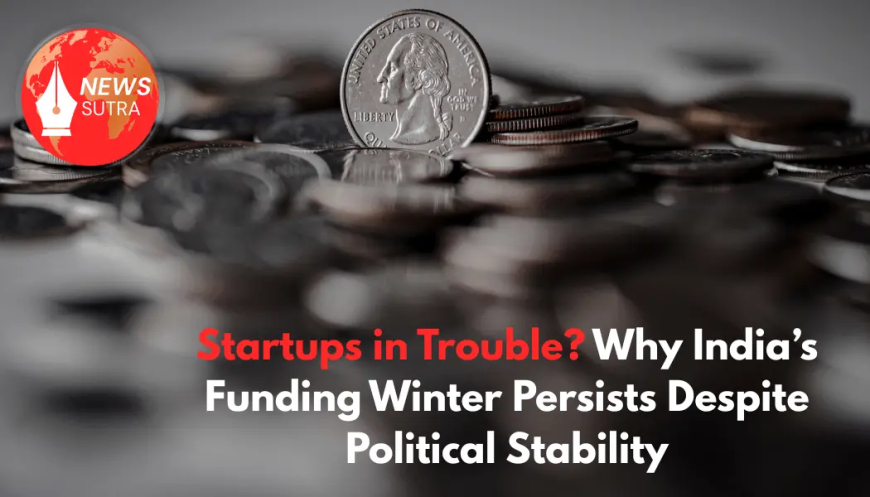Startups in Trouble? Why India’s Funding Winter Persists Despite Political Stability
Despite political stability and macroeconomic optimism, India’s startup ecosystem is battling a prolonged funding winter. Here’s why capital inflow is drying up and what it means for the innovation economy.

Startups in Trouble? Why India’s Funding Winter Persists Despite Political Stability
The Indian startup ecosystem, once hailed as a global hotspot of innovation and disruption, is now grappling with an unnerving chill. Despite the reassurance of political stability following the 2024 general elections, startups across sectors are witnessing a sustained funding winter that shows no signs of thawing.
With venture capital firms tightening their purse strings and valuations being slashed, questions arise: Why is investor confidence still low? And what does this mean for the future of India’s new-age enterprises?
Funding Winter 2.0: The Numbers Don’t Lie
According to data from Tracxn, Indian startups raised just $2.1 billion in Q1 2025, a 39% drop compared to the same period last year. Early-stage investments took the hardest hit, with pre-Series A and seed-stage deals plummeting over 50%. This decline marks the lowest quarterly funding figure since mid-2020—during the peak of the pandemic shock.
Notably, marquee startups like Byju’s, Ola, and Udaan have either paused expansion or laid off large portions of their workforce. Even previously hot sectors like fintech and edtech have cooled considerably in investor sentiment.
1. Political Stability ≠ Investment Surge
While India’s political climate is stable—with the incumbent government returning to power with a decisive mandate—the expected capital surge hasn’t followed. Analysts had hoped that policy continuity would re-ignite investor appetite. However, Bain & Company’s India Venture Capital Report highlights that macro stability alone is not enough to reverse investor caution.
Why? Political stability matters, but risk appetite is primarily influenced by global capital markets, interest rate environments, and return expectations—factors beyond New Delhi’s control.
2. Global Capital Retrenchment
India’s funding winter is symptomatic of a broader global trend. As the U.S. Federal Reserve maintains elevated interest rates, global venture funds are shifting from high-risk, long-gestation tech bets to safer, income-generating assets.
Venture capitalists are also facing liquidity constraints. Exit opportunities have diminished due to fewer IPOs and M&A deals, making it harder for funds to recycle capital. A PitchBook report confirms that global venture funding fell 42% year-over-year, with India following a similar trajectory.
3. Valuation Reset and the End of Hypergrowth
The days of "growth at any cost" are officially over. Startups are now under pressure to turn profitable or perish. High-profile unicorns that once raised billions on bloated valuations are now struggling to justify their worth.
In early 2025, SoftBank and Tiger Global both announced write-downs in their Indian portfolios. Founders are being asked to show actual revenues, healthy unit economics, and a path to profitability before receiving any additional funds.
This correction, while healthy in the long term, has led to a painful transition phase. Companies like Meesho, ShareChat, and PharmEasy have either postponed their IPOs or drastically slashed their internal valuations.
4. Limited Domestic VC Depth
India still lacks a strong domestic venture capital base. While institutions like Blume Ventures and Chiratae Ventures are actively deploying capital, they cannot replace the scale and aggressiveness of global players.
Most large domestic capital pools—from LIC to pension funds—remain conservative, preferring listed equities and debt instruments over startups. Until Indian institutional investors develop a higher risk appetite and policy support is enhanced, dependence on foreign VC will continue to limit resilience during global shocks.
5. Sector-Specific Shocks
-
Edtech: Once the pandemic darling, edtech is facing mass layoffs and declining subscriptions as offline schools and colleges reopen.
-
Fintech: Stricter RBI regulations on digital lending, KYC norms, and payment gateways have cooled investor enthusiasm.
-
Quick Commerce: Loss-making delivery models have failed to find sustainable monetization, resulting in down rounds and shutdowns.
However, sectors like SaaS, climate tech, and deep tech are showing resilience, with companies like Icertis and ReNew Power still attracting interest due to their global market relevance and clearer unit economics.
6. Founders Recalibrating Strategies
Faced with drying capital, Indian startups are being forced to adapt:
-
Operational Efficiency: Companies are cutting burn rates and pivoting to leaner models.
-
Profitability Focus: More startups are aiming to break even sooner, even at the cost of scaling down operations.
-
Alternative Capital: Some are turning to venture debt, convertible notes, and government-backed funds such as SIDBI’s Fund of Funds for support.
This recalibration could foster a healthier startup environment, where growth is sustainable and not solely dependent on investor sentiment.
7. What Needs to Change?
-
Policy Innovation: The government must go beyond Startup India rhetoric. Regulatory clarity on ESOPs, angel tax, and cross-border investments is crucial.
-
Tax Reliefs: Measures such as easing the long-term capital gains tax and reducing GST burdens on SaaS and digital goods can make India a more startup-friendly ecosystem.
-
Local LP Ecosystem: Creating frameworks for pension funds and insurance companies to invest in VC funds can add a layer of capital stability.
Invest India and NITI Aayog are working on ecosystem reforms, but execution speed and depth remain areas of concern.
Conclusion: Winter May Last Longer Than Expected
India’s startup landscape is at a pivotal juncture. The slowdown isn’t a mere blip—it reflects structural recalibrations in investor expectations, global capital flows, and founder strategies. While political stability provides a solid foundation, it alone cannot reignite risk appetite or reverse the funding drought.
In many ways, this is a necessary reset—one that will separate hype from substance, vanity metrics from real impact. The coming quarters may remain chilly, but startups that embrace capital discipline, customer focus, and clear business models will eventually emerge stronger.
What's Your Reaction?
 Like
0
Like
0
 Dislike
0
Dislike
0
 Love
0
Love
0
 Funny
0
Funny
0
 Angry
0
Angry
0
 Sad
0
Sad
0
 Wow
0
Wow
0






































































